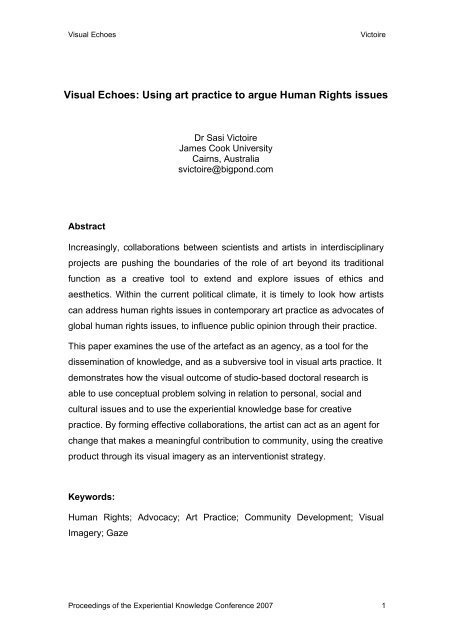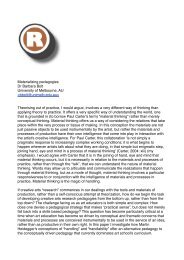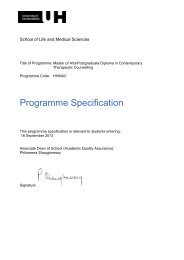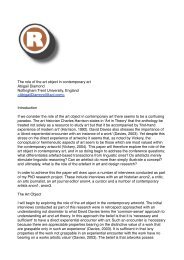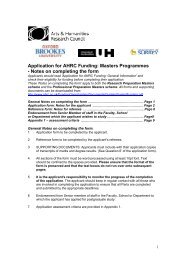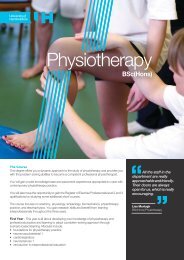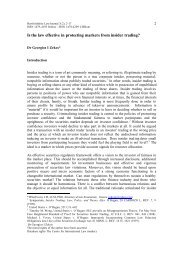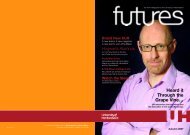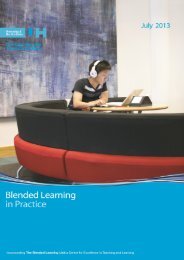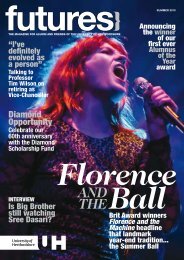Visual Echoes: Using art practice to argue Human Rights issues
Visual Echoes: Using art practice to argue Human Rights issues
Visual Echoes: Using art practice to argue Human Rights issues
Create successful ePaper yourself
Turn your PDF publications into a flip-book with our unique Google optimized e-Paper software.
<strong>Visual</strong> <strong>Echoes</strong>Vic<strong>to</strong>ire<strong>Visual</strong> <strong>Echoes</strong>: <strong>Using</strong> <strong>art</strong> <strong>practice</strong> <strong>to</strong> <strong>argue</strong> <strong>Human</strong> <strong>Rights</strong> <strong>issues</strong>Dr Sasi Vic<strong>to</strong>ireJames Cook UniversityCairns, Australiasvic<strong>to</strong>ire@bigpond.comAbstractIncreasingly, collaborations between scientists and <strong>art</strong>ists in interdisciplinaryprojects are pushing the boundaries of the role of <strong>art</strong> beyond its traditionalfunction as a creative <strong>to</strong>ol <strong>to</strong> extend and explore <strong>issues</strong> of ethics andaesthetics. Within the current political climate, it is timely <strong>to</strong> look how <strong>art</strong>istscan address human rights <strong>issues</strong> in contemporary <strong>art</strong> <strong>practice</strong> as advocates ofglobal human rights <strong>issues</strong>, <strong>to</strong> influence public opinion through their <strong>practice</strong>.This paper examines the use of the <strong>art</strong>efact as an agency, as a <strong>to</strong>ol for thedissemination of knowledge, and as a subversive <strong>to</strong>ol in visual <strong>art</strong>s <strong>practice</strong>. Itdemonstrates how the visual outcome of studio-based doc<strong>to</strong>ral research isable <strong>to</strong> use conceptual problem solving in relation <strong>to</strong> personal, social andcultural <strong>issues</strong> and <strong>to</strong> use the experiential knowledge base for creative<strong>practice</strong>. By forming effective collaborations, the <strong>art</strong>ist can act as an agent forchange that makes a meaningful contribution <strong>to</strong> community, using the creativeproduct through its visual imagery as an interventionist strategy.Keywords:<strong>Human</strong> <strong>Rights</strong>; Advocacy; Art Practice; Community Development; <strong>Visual</strong>Imagery; GazeProceedings of the Experiential Knowledge Conference 2007 1
<strong>Visual</strong> <strong>Echoes</strong>Vic<strong>to</strong>ireIntroductionThis paper examines the use of <strong>art</strong> as agency. As such the <strong>art</strong>efact or <strong>art</strong>product driven by conceptual framework becomes a <strong>to</strong>ol for the disseminationof knowledge. It operates as a subversive <strong>to</strong>ol in visual <strong>art</strong>s <strong>practice</strong>. The useof experiential knowledge base by using conceptual problem solving inrelation <strong>to</strong> personal, social and cultural <strong>issues</strong> can drive creative <strong>practice</strong> <strong>to</strong>become the visual outcome for studio-based doc<strong>to</strong>ral research.Creative Production and <strong>Human</strong> <strong>Rights</strong>Within the current political climate it is most relevant for <strong>art</strong>ists <strong>to</strong> act asadvocates of global human rights <strong>issues</strong> and <strong>to</strong> influence public opinionthrough contemporary <strong>art</strong> <strong>practice</strong> for community development for example, in<strong>issues</strong> of child safety, domestic violence and racial bias. The <strong>art</strong>ist is able <strong>to</strong>responsibly and independently target capacity building, address questionsthrough critical dialogue and raise awareness of established power bases. Itsuggests a greater value for <strong>art</strong> <strong>practice</strong>, as a more transferable, versatileproduct that is able <strong>to</strong> collaborate with other <strong>art</strong> <strong>practice</strong>s like performance orfilm <strong>to</strong> occupy sites other than the traditional gallery.Creative production is a term filled with ambiguous notions and fluiddefinitions. When examined closely, creative production is identified through anumber of elements. It involves an initial idea or notion that stimulates orpropels the process from which a final outcome is realised through thecreative product. Creative production relies on the skill and expertise of the<strong>art</strong>ist for its final outcome. The assessment, however, of the value or successof the creative product is based on an external variable, the viewer (made upof the gallery audience, peer group or critics).It is undeniable that the viewer continually places demands for innovation andentertainment. In his book What’s Wrong with Contemporary Arts, Timmsstates that the promotion takes place in visual culture through ‘an increasingcommodification and trivialisation of <strong>art</strong>’ (Timms, 2004). Timms <strong>argue</strong>s thatincreasingly <strong>art</strong>ists' careers are dependent on the amount of publicity theyattract. Artists succumb <strong>to</strong> ‘visual gags, titillation, public scandal orplatitudinous commentaries on newsworthy social issue, under the pretenceProceedings of the Experiential Knowledge Conference 2007 2
<strong>Visual</strong> <strong>Echoes</strong>Vic<strong>to</strong>ireof challenging public perceptions’ (Timms, 2004:11). Artists who show theirwork cannot ignore their relationship with the viewer and the viewer’sresponse <strong>to</strong> complete the dialogue (analysis in terms of looking). The relianceon the viewer <strong>to</strong> complete the creative process places the <strong>art</strong>ist increasingly atthe mercy of the viewer as an intangible, insatiable and unreliable entity.<strong>Visual</strong> culture depends on the reception of the meaning behind the <strong>art</strong> andopen dialogue for communication of <strong>issues</strong> in current <strong>art</strong> <strong>practice</strong>. Aresponsible <strong>art</strong>ist with a social conscience, who wants <strong>to</strong> contribute and berelevant in society, cannot be anything but political and interventionist in thisglobal climate of excess and violence. It is possible for <strong>art</strong>, through itsimagery, <strong>to</strong> be ‘respectful <strong>to</strong>wards, yet at the same time more demanding ofits audience’ and not be ‘facile nor wilfully abstruse, rewarding patience,knowledge and dedication’. Timms <strong>argue</strong>s in support of ‘greater intellectual,emotional and psychological complexity as a counter <strong>to</strong> market drivenpopularisation’ and <strong>to</strong>wards a trend that is more demanding of its audience(Timms 2004: 13).By placing humanist ideals in <strong>art</strong> <strong>practice</strong> an <strong>art</strong>ist is able <strong>to</strong> drive an authenticagenda that benefits community and creates meaning for the audience. Kellyin Art and <strong>Human</strong>ist Ideals: Contemporary Perspectives <strong>argue</strong>s there is agrowing trend for humanist ideals in <strong>art</strong> <strong>practice</strong> because ‘<strong>art</strong> has the capacity<strong>to</strong> be prescient and <strong>to</strong> share both knowledge and a worldview with sensitivity,compassion, and wisdom.’ He maintains that due <strong>to</strong> its conceptual position itis ‘the expression of human impulses that cross all media borders and virtuallyall stylistic boundaries’ (Kelly 2003:11).Arts Patronage and Institutionalised FundingIt is also pertinent in this age of economic rationalism, <strong>to</strong> examine the <strong>art</strong>s ratein Australia through the nation’s allocation of funds for the community andcultural <strong>art</strong>s development. In recent times the area of community and cultural<strong>art</strong>s development has undergone major changes with the questioning of itsvalue. Due <strong>to</strong> the absence of alternatives for funding, <strong>art</strong>ists are compelled <strong>to</strong>respond <strong>to</strong> institutionalised national funding networks, like the AustraliaCouncil and the State funding bodies like Arts Queensland. The criteria for theProceedings of the Experiential Knowledge Conference 2007 3
<strong>Visual</strong> <strong>Echoes</strong>Vic<strong>to</strong>iregovernment funding bodies are seemingly democratic, by engaging in theprinciples of best <strong>practice</strong>. For the allocation of grants, proven <strong>art</strong>ists areselected under rigorous, defined criteria before a panel of assessors whoplace the applicants in rank order <strong>to</strong> gauge the value of applications beforethem. Creative production is then often framed and propelled through thesedefined policy ‘outcomes’ that leads <strong>to</strong> the question of au<strong>to</strong>nomy in thecreative production.When grants are allocated, <strong>art</strong>ists are required <strong>to</strong> document and gather datafor grant acquittal at the end of the project. For the <strong>art</strong>ists the data available islimited <strong>to</strong> peer feedback, the exhibition report, the visi<strong>to</strong>rs’ book in galleriesand anecdotal reports. To acquit grant monies and further their <strong>art</strong> <strong>practice</strong>the <strong>art</strong>ists have limited methodologies <strong>to</strong> gather evidence of success. The<strong>art</strong>ist cannot rely on the aesthetic response (difficult <strong>to</strong> gauge as it may bemetaphorical, emotional and subliminal) but on the attendance numbers attheir exhibition; a system that is reinforced by Government policy.Gauging Aesthetic responseI align with Kelly in stating that ‘the <strong>art</strong>s can address his<strong>to</strong>ric/metaphoric truth,act in the important role as witness, reference injustice, help <strong>to</strong> raise the baron awareness of human dignity and create images which are moving andspiritual in the deepest sense’ (Kelly, 2003:116). To illustrate the power andpotential of <strong>art</strong> Kelly highlights how Picasso’s Guernica was a dualcontribution <strong>to</strong> <strong>art</strong> and humanity <strong>to</strong> change the tide of his<strong>to</strong>ry using Picasso’scomment that ‘a painting can never s<strong>to</strong>p a bullet’ but that ‘a painting can s<strong>to</strong>pa bullet from being fired’ (Kelly, 2003: 117). Unfortunately, this knowledge islost on the policy makers of our nations.The ability <strong>to</strong> gauge aesthetic response is elusive. The success of thehumanist contribution in creative production is difficult <strong>to</strong> quantify and cannotclearly be measured within the data gathered by the <strong>art</strong>s industry <strong>to</strong> supportan argument for the cultural and social health of our nation. However, theCultural Policy Centre, at the University of Chicago, in a project called‘Measuring the Aesthetic Experience’, has attempted <strong>to</strong> address a wide rangeof theoretical, methodological and policy <strong>issues</strong> by ‘drawing on anProceedings of the Experiential Knowledge Conference 2007 4
<strong>Visual</strong> <strong>Echoes</strong>Vic<strong>to</strong>irevisual stimulation, needs <strong>to</strong> prioritise the value of the visual image. To keepthe interest of the audience ‘visual gags’ are relevant <strong>to</strong> the <strong>art</strong> making. As apracticing <strong>art</strong>ist, my awareness of the role of visual imagery and the capacityof the audience <strong>to</strong> absorb and digest the meaning and messages in myexhibition is an essential criterion in gauging the success of my visual produc<strong>to</strong>r creative <strong>art</strong>efact. An exhibition has <strong>to</strong> compete with mass culture for anaudience.This leads me <strong>to</strong> question my reliance on the ‘interpretive strategies beyondthe now familiar use of semiotic terminology’ (Mirzoeff, 1999: 13), that Iemploy as ‘visual gags’ <strong>to</strong> targeted audience. As an <strong>art</strong>ist, when addressingsocial <strong>issues</strong>, it is imperative <strong>to</strong> use strategies <strong>to</strong> inform, motivate andchallenge the viewer, <strong>to</strong> go beyond a passive reception of the visualconstruction as p<strong>art</strong> of the objective. I align with a humanist approach in mycreative production and thus have responsibilities <strong>to</strong> uncover human rights<strong>issues</strong>. This includes the need <strong>to</strong> convey embedded rhe<strong>to</strong>ric and <strong>to</strong> reachuninitiated audiences beyond the mere aesthetic within the creative product.The imagery or creative product must have some personal significance orappeal <strong>to</strong> engage an audience in a tangible way. The visual researchembedded in my <strong>art</strong>work deals with how an individual life has beenconstructed through the process of looking. The research investigates theextent <strong>to</strong> which structures exist in the Indian culture, <strong>to</strong> scaffold the way thegaze operates from my experience.<strong>Using</strong> self (I) as subject in this research, I construct my identity using thenarratives in my life, strengthened by the feminist ideology of ‘personal ispolitical’ (Webster, 1992: 121). I explore these areas through myself andthrough my eyes (self gaze) as the most accessible subject. My ‘culture, race,age, sexual orientation, ability, and class privilege may influence (my)readings by placing me in certain positions in relation <strong>to</strong> any narrative’(Goodman, 1992: 67). While the research orientation is from my personalexperience (hybrid position as a migrant from Malaysian/Indian heritage) andthus includes Eastern perspectives, it is necessary <strong>to</strong> examine <strong>issues</strong> fromWestern psychoanalytic frameworks in literature for positional analysis.Proceedings of the Experiential Knowledge Conference 2007 6
<strong>Visual</strong> <strong>Echoes</strong>Vic<strong>to</strong>ireFrom the literature, relational sets of values have been derived <strong>to</strong> identify theobject and the subject of the gaze. The analysis of the gaze in amethodological framework is problematic; I am the person who is doing thegazing at myself, at the conditions around me as the specta<strong>to</strong>r, and I alsoplaced myself as the object of my own scrutiny. Thus within this work I am theprotagonist, the narra<strong>to</strong>r and the object in a valid, complex, dialogicalrelationship as child, as adult, as object, as subject and also as protagonistand narra<strong>to</strong>r.Early painters have investigated similar themes using various strategies forexample the use of reflections in mirrors in Van Eyck’s (1434) ArnolfiniMarriage, <strong>to</strong> a more contemporary post modern visual analysis of looking inPeter Tyndall’s (1997), A person looks at a work of <strong>art</strong>/ someone looks atsomething.Power of persuasive imageryHis<strong>to</strong>rically, <strong>art</strong> has played a definite role as an agency for change in which<strong>art</strong>ists have overtly or covertly played a significant role in raising awareness ofpolitical, social and environmental <strong>issues</strong>, but solely within male gaze.Feminist <strong>art</strong> reveals heavy bias and attempts <strong>to</strong> redress the existingimbalance through <strong>art</strong> <strong>practice</strong>. By taking on cultural production, feminist<strong>art</strong>ists have been able <strong>to</strong> shift the politics of representation and the internaldialogue locked in by the gaze. Subversive <strong>art</strong> is an effective, covert <strong>to</strong>ol <strong>to</strong>keep alive the discourse against patriarchal control, <strong>to</strong> reclaim the gaze and <strong>to</strong>continue ‘the challenge of imaging women as subjects who claim politicalrights and visual representation’ (Cherry, 2000: 2).Thus ‘woman’ becomes a catalyst and provides the paradigm <strong>to</strong> questionassumptions inherent in society that worked against women. This paperdemonstrates how by using outcomes of visual research an <strong>art</strong>ist is able <strong>to</strong>embed strategies as an active change agent. The strategy underlying theresearch is <strong>to</strong> take active control of the personal narrative <strong>to</strong> expose theextent <strong>to</strong> which external gazes have constructed self-identity and the ultimatereality of the <strong>art</strong>ist’s life through religious and cultural mores.Proceedings of the Experiential Knowledge Conference 2007 8
<strong>Visual</strong> <strong>Echoes</strong>Vic<strong>to</strong>ireHow the gaze forms the primary conceptual framework that contributes <strong>to</strong> thevisual research and <strong>to</strong> raise human rights <strong>issues</strong> for community developmentis set out below in Table 1, entitled Global Hangers.Table 1:Global HangersFor the visual enquiry, analysis of the layers of cultural veils provides thequestioning of the politics of power that continue <strong>to</strong> impact upon the lives ofwomen. It enables the researcher <strong>to</strong> gather specific subversive data for theProceedings of the Experiential Knowledge Conference 2007 9
<strong>Visual</strong> <strong>Echoes</strong>Vic<strong>to</strong>ireexhibition within the cultural frames and within body politics. The theoreticalfilters and societal filters in the figure also detect the patriarchal frameworks insociety that scaffold stereotypes, male privilege and prevalent attitudes inmass media that impact negatively on women. These are then translated in<strong>to</strong>visual concepts, verbal concepts and cultural concepts for the <strong>art</strong> making inan exhibition.Artworks Agenda Subversion StrategiesCultural Windows 1- 4 Oppression of and violenceagainst women in culturalframeworks that serve maleprivilegeExposing the role of gaze incultural and religiousframeworks that servepatriarchal agendasBollywood GazeComplicit behaviour of womenthrough mass cultureUncovering the role ofspecta<strong>to</strong>rship in masculinegaze in erotic/exoticCon Words Reinforcement of complicitbehaviour in women throughcensorship and scrutinyBlack/White Oppression throughdifference/colourIssues of power relations andbody politicsExposing power politicsGaze, Gaze 1, Lower yourgaze, Fractured gaze,I rested my questioning eyeson my mother,Her eyes created theboundaries for mybehaviour, Hope ChestFamily values, VirtuousWoman/Sati, AcquiescenceReligious Gaze,PrivilegedGlass Ceiling, States ofBeing, Multiple gazeSocietal oppression and pressure<strong>to</strong> elicit submissive andsubservient behaviour in womenDomination and cultural controlthrough the gaze in familyrelationships and in personalbehaviourReligious precepts and codesthat serve patriarchy <strong>to</strong> harnesswomen’s behaviour and <strong>to</strong>procure compliance for thebenefit of patriarchyObstacles and limitations placedon women <strong>to</strong> inhibit theiradvancementUncovering role of the gaze asa mechanism of control <strong>to</strong> servepatriarchal needsHighlighting role of gaze infamily relationshipsExposing translations anddeliberate misinterpretations inreligious codes <strong>to</strong> benefitpatriarchyAwareness of empowermentstrategies for economic stabilityand personal au<strong>to</strong>nomyVideo on forum Visibility of women’s <strong>issues</strong> Role of gaze for control ofwomen in societyTable 2:Subversion Strategies in ArtworksProceedings of the Experiential Knowledge Conference 2007 10
<strong>Visual</strong> <strong>Echoes</strong>Vic<strong>to</strong>ireThe stimuli from these concepts translate in<strong>to</strong> subversive imagery as shown inTable 2 for the iconographic language in the works for the exhibition Throughthe Looking Glass. While studio based visual research is open <strong>to</strong> normalexperimentation and spontaneous discoveries, it is heavily underpinned bygoal-oriented concepts that target the inherent social <strong>issues</strong>.Investigating cultural frameworks (within Hindu, Christian, Chinese andMuslim contexts), reveal rich visual imagery. Research in<strong>to</strong> <strong>issues</strong> like footbinding,screening and veiling, widow burning, the contemporary <strong>practice</strong> ofleg stretching and dress codes in fashion, reveal unquestioned male authorityembedded in religious texts where access <strong>to</strong> advancement for women isdenied. It provides the potential <strong>to</strong> choose and develop imagery thatcontributes <strong>to</strong> the aims of this thesis (woman as <strong>art</strong>efact) and establishes therole of the gaze as the conceptual source of the visual investigation.From the conceptual base, the global hangers form the basis for collectingand sorting. As soon as a concept is developed on both conscious andunconscious level relevant material that inform the rhe<strong>to</strong>ric is fossicked fromopportunity shops, hardware shops, second hand shops, recycling centresand antique shops. Found objects are assembled and combined with painting,printmaking or collage <strong>to</strong> form coherent statements. The final product as anexhibition uses a variety of inventive, collaborative approaches includinginstallations, where pho<strong>to</strong>graphy, mixed media, glass and digital media,enhance the delivery of meanings and messages in the work.In my role as protagonist, the gaze is analysed within a variety of culturalsettings <strong>to</strong> demonstrate that it is loaded with implications and used as amechanism of control in society. Religious precepts are probed <strong>to</strong>demonstrate that women have themselves colluded <strong>to</strong> their continueddetriment and subordination.For the visual analyses, I investigate them as individual windows usingspecific colours, rice paper patterns and design <strong>to</strong> reflect their own culturalstyle. The windows are shadow boxes divided in<strong>to</strong> sections, each able <strong>to</strong> beseen as stand-alone work and in comp<strong>art</strong>ments <strong>to</strong> provide insight in<strong>to</strong> the fourexplored cultures (Figure 1).Proceedings of the Experiential Knowledge Conference 2007 11
<strong>Visual</strong> <strong>Echoes</strong>Vic<strong>to</strong>ireFigure 1:Cultural windowsFor instance, using the Chinese three-inch Lotus shoes and exploring footbinding provided the visual language for constraint and cultural restriction(Figure 2).Figure 2: Three inch-Lotus shoesThe concepts are further unpacked by comparing current <strong>practice</strong>s with oldcus<strong>to</strong>ms <strong>to</strong> collectively bring them <strong>to</strong>gether under the framework of theProceedings of the Experiential Knowledge Conference 2007 12
<strong>Visual</strong> <strong>Echoes</strong>Vic<strong>to</strong>irewindow (Figure 3). The words, gaze, window, body as an object, glass,mirrors, violence, widow burning trigger visual imagery that serve as potentialvisual cues and windows become an apt metaphor <strong>to</strong> analyse each culturalframework. Through the interaction with a series of cultural windows theaudience is able <strong>to</strong> make metaphorical connections between the patriarchalstructures and <strong>to</strong> the violence that occurs in the lives of women.Figure 3:Cultural window 1 (Chinese)Feminist theoretical principles strengthen the premise on the gaze in terms of<strong>issues</strong> of power relations, and reveal that culture, religion, <strong>art</strong> and fashion allcollude <strong>to</strong> confine and restrict the lives of women through the process of‘looking.’ Investigations in<strong>to</strong> looking in and looking out convey a variety ofmeanings <strong>to</strong> support the visual analysis of the positions <strong>to</strong> dismantle existingProceedings of the Experiential Knowledge Conference 2007 13
<strong>Visual</strong> <strong>Echoes</strong>Vic<strong>to</strong>irepower structures using text and mirrors <strong>to</strong> make visible the <strong>issues</strong> of powerand control, heavily disguised in culture, <strong>to</strong> elicit compliance from the women.As <strong>art</strong>efacts, the <strong>art</strong>works that emerge from the visual investigation andresearch further provide the visual link <strong>to</strong> reinforce the inherent personal,theoretical and political <strong>issues</strong>. Subtle and covert messages of complianceand control are included as sandblasted text on glass, as signifier of thedirection the <strong>art</strong>ist intends <strong>to</strong> unfold rhe<strong>to</strong>ric. The meanings and semioticsembedded in the words obey, comply, control, restrict, all become useful <strong>to</strong>ols<strong>to</strong> raise awareness of body politics (Figures 4,5,6)Figure 4:Installations with Mirrors & MannequinsProceedings of the Experiential Knowledge Conference 2007 14
<strong>Visual</strong> <strong>Echoes</strong>Vic<strong>to</strong>ireFigure 5: Con Words Figure 6: Black & WhiteBy using mirrors <strong>to</strong> dismantle the word, ‘reflections’ and by assemblingvarying thickness of glass the covert nature in the gaze is revealed in theworks. <strong>Using</strong> fusing techniques and by using various levels of opacity of theglass, sharp fragments or shards of glass are assembled <strong>to</strong> imp<strong>art</strong> degrees ofsubtleties. They conveyed different states of representation and deflection. Todecrease the visibility further and <strong>to</strong> imp<strong>art</strong> the danger contained in the word,gaze is added at the centre of the slab yet again <strong>to</strong> provide a consistent visualclue for the audience (Figure 7).Proceedings of the Experiential Knowledge Conference 2007 15
<strong>Visual</strong> <strong>Echoes</strong>Vic<strong>to</strong>ireFigure 7: Fractured Gaze, mixed media under slumped glassAs further visual exploration, the theoretical <strong>issues</strong> that remain embedded inthe gaze were unpacked <strong>to</strong> create appropriate visual imagery in the <strong>art</strong>efact(Figures 8 & 9).Figure 8: Gaze 1, mixed media under slumped glassProceedings of the Experiential Knowledge Conference 2007 16
<strong>Visual</strong> <strong>Echoes</strong>Vic<strong>to</strong>ireFigure 9: Religious Gaze, mixed media under slumped glassAs a strategy for inclusion, consistent with feminist ideology, a videopresentation of a forum involving comments of diverse women of the NorthQueensland was added. This forum gave a local context, created interactionand developed awareness for a dialogue <strong>to</strong>wards visibility and empowerment.The women from diverse ages, background and levels of society fulfilled theethical considerations for data documentation collecting, and recording andvoluntarily signed the consent agreement before p<strong>art</strong>icipating in the forum.Eyes as an image, represents the gaze most effectively. Many of the womenwere also included in a final piece of work for the universal gaze where onlytheir eyes were pho<strong>to</strong>graphed and included in Multiple Eyes. (Figure 10)Proceedings of the Experiential Knowledge Conference 2007 17
<strong>Visual</strong> <strong>Echoes</strong>Vic<strong>to</strong>ireFigure 10:Multiple Gazes, digital pho<strong>to</strong> on canvasTo defy the gaze, the deliberate reinforcement of empowerment strategies areincluded in the <strong>art</strong>efacts <strong>to</strong> promote women’s growth and wellbeing thusfulfilling the researcher’s human rights goals. (Figures 11 &12)Figure 11:Glass Ceiling, installationProceedings of the Experiential Knowledge Conference 2007 18
<strong>Visual</strong> <strong>Echoes</strong>Vic<strong>to</strong>ireAs installations, Glass Ceiling, (Figure 11) and States of Being (Figure 12)uncovered visually the restrictions placed on women and also the need forempowerment strategies. Birdcages were mediated as 3D drawings <strong>to</strong>highlight, visually, caged women in societal traps, victimised in patriarchalenvironments. Individual cages include text <strong>to</strong> serve as apt metaphors forlevels of restriction in the lives of women. They were positioned in aninteresting rhythm, stepping them up in ascending order with the doors on thelast three cages left open, reflecting positive outcomes that signify freedomand growth.Figure 12:States of Being, InstallationOutcomes of researchBy using imagery as its strategy, the exhibition successfully uncovers thepolitics of the representation of women and creates awareness of theinstitutional framework that determines the reading of the role of women. Theoutcome of the exhibition was measured by the traditional feedback fromaudiences through entries in the visi<strong>to</strong>rs’ book, e-mails, phone calls and theresulting reviews within traditional gallery environments. The exhibition <strong>to</strong>ursin Queensland created a series of unexpected outcomes that acknowledgedthe significance of the visual imagery in the exhibition. This was the ability ofProceedings of the Experiential Knowledge Conference 2007 19
<strong>Visual</strong> <strong>Echoes</strong>Vic<strong>to</strong>irethe visual imagery in the exhibition <strong>to</strong> connect with diverse audiences,targeting both women and children from non-English speaking backgroundsexperiencing domestic and/or sexual violence.I was invited by Immigrant Women’s Support Service <strong>to</strong> be a keynotespeaker and present the exhibition work in November 2006 at their forum. Theforum was entitled Moving Beyond Rhe<strong>to</strong>ric <strong>to</strong> Diversity in Practice: a <strong>Human</strong><strong>Rights</strong> Framework <strong>to</strong> Address Violence Against Women. It was seeking <strong>to</strong> findnew solutions <strong>to</strong> violence by sharing information with other key agencies,including policy makers, service providers and academics. The feedbackreceived from the forum has strengthened the value of visual interpretationthrough the recognition of <strong>art</strong> as a unique interventionist strategy <strong>to</strong>communicate social <strong>issues</strong>. Another outcome was the invitation <strong>to</strong> contribute<strong>to</strong> the publication of Kasama, the newsletter of the Solidarity PhilippinesAustralia Network with an <strong>art</strong>icle on the value of visual imagery, entitled, ThePower of Persuasion in <strong>Visual</strong> Imagery. As a result of the exhibition, Icontinue <strong>to</strong> discover more interest from non traditional audiences, the latestbeing at the International Feminist Summit, Women of Ideas: FeministThinking for a New Era, <strong>to</strong> be held in Townsville, Australia on 17–20 July2007.The acknowledgement of the role of <strong>art</strong>ist as change agent <strong>to</strong> contribute <strong>to</strong>real solutions suggests that there is potential for issue-based work <strong>to</strong> extendbeyond traditional sites and also strengthen the value of <strong>art</strong> in society and theeffectiveness of visual imagery <strong>to</strong> reach a wider target of audiences in avariety of environments.Art has subversive currency elevate the role of <strong>art</strong>ist in society by contributingmeaningfully <strong>to</strong> debate and discourse. Artists are able <strong>to</strong> develop new ways <strong>to</strong>access new audiences, <strong>to</strong> reveal political and social agendas, encouragehuman rights elements in <strong>art</strong>work and create exciting collaborations that cancontribute and influence government policies for the advancement of society.Thus the <strong>art</strong>ist as witness, through the <strong>art</strong>efact or creative product, is able <strong>to</strong>document, exchange knowledge, disperse information and communicatealternative positions by challenging existing notions in support ofsocial/human rights <strong>issues</strong> with clarity, courage and forthrightness. ThisProceedings of the Experiential Knowledge Conference 2007 20
<strong>Visual</strong> <strong>Echoes</strong>Vic<strong>to</strong>ireenables <strong>practice</strong>-based research in <strong>art</strong> disciplines and the resulting innovativecreative product <strong>to</strong> be used in challenging new ways as a knowledge-based,collaborative <strong>to</strong>ol when placed <strong>to</strong>gether with academics, researchers andpolicy makers.Contribu<strong>to</strong>r BiographyDr Sasi Vic<strong>to</strong>ire is a graduate of the School of Creative Arts, James CookUniversity, Cairns Australia. She is a visual <strong>art</strong>ist, works in education, in <strong>art</strong>sand community development. She resides and exhibits extensively in Cairnsand <strong>to</strong>urs widely in regional Queensland. Her latest exhibition, Through theLooking Glass highlighting women’s <strong>issues</strong> on violence against women,<strong>to</strong>ured regional centres from 2004-2007.ReferencesBeauvoir, S. de, (1972), The Second Sex, England: Penguin Books.Bonner, F., Goodman L, Allen R., James L, King C. eds, (1992), ImaginingWomen, United Kingdom: Polity Press.Cherry, D., (2000), Beyond the Frame Feminism and <strong>Visual</strong> culture, Britain1850-1900, London and New York: Routledge, (Taylor and Francis Group).Goodman, L., (1992). Goodman, Bonner, F., Goodman L, Allen R., James L,King C. (eds.), 1992, in Imagining Women, Forward <strong>to</strong> LiteraryRepresentations: Self as a subject, United Kingdom: Polity Press.Kelly, W., (2003), Art and <strong>Human</strong>ist Ideals: Contemporary Perspectives,Macmillan Publishers.Mirzoeff, N., (1999), An Introduction <strong>to</strong> <strong>Visual</strong> Culture, London and New York:Routledge, Taylor and Francis Group.O'Muirche<strong>art</strong>aigh C., (2001), Measuring the Aesthetic Experience, CulturalPolicy Centre University of Chicago,http://www.<strong>art</strong>scatalyst.org/general/GENERAL_index.htmlAccessed 4.02.2007.Timms. P., (2004), What’s Wrong with Contemporary Arts? Sydney, Australia,University of New South Wales Press Ltd.Proceedings of the Experiential Knowledge Conference 2007 21
<strong>Visual</strong> <strong>Echoes</strong>Vic<strong>to</strong>ireTurner, C. (2003) Artists and <strong>Human</strong> <strong>Rights</strong>: Witnessing <strong>to</strong> Silence,http://www.anu.edu.au/hrc/research/W<strong>to</strong>S/Turner.pdf Accessed 2.02.2007.Webster, W., (1992), Our Life: working-class women’s au<strong>to</strong>biography, Britain,in (Bonner et al.) 1992, 121.Art works citedPablo Picasso, Guernica, Oil on canvas, Museo Reina Sofia, Madrid, 1937.Peter Tyndall (1997), A person looks at a work of <strong>art</strong>/ someone looks atsomething; 1997: 215, Art & Australia Vol 35 No. 2, Sydney, Australia FineArts Press Pty., Ltd.Van Eyck (1434) Arnolfini Marriage, Oil on panel National Gallery, London,1994:153, The ART Book, London, Phaidon Press Ltd.Proceedings of the Experiential Knowledge Conference 2007 22


